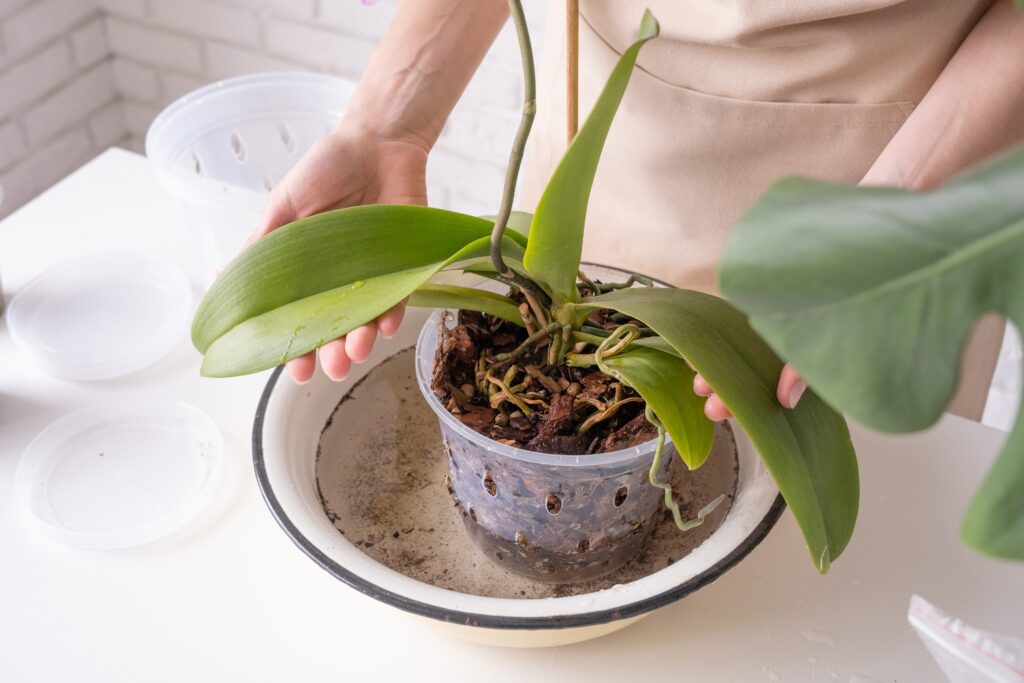Blog
How Often to Water Orchids: A Complete Guide to Proper Watering
Every orchid grower knows that watering these delicate plants can feel like walking on a balance beam. Lean too far one way with overwatering, and your roots rot; lean the other with underwatering, and your leaves shrivel. It’s understandably not easy to get perfect.
Though each species of orchid might have some specific watering requirements, most orchids follow the same general watering pattern and guidelines, which we’ll cover in this article. Keep in mind that potting medium also plays a role. Growing orchids in bark, for example, brings its own set of care requirements.
Let’s clarify how often to water orchid plants and, more importantly, why these beautiful flowers need such specific care. After all, understanding the ‘why’ behind watering techniques helps develop a masterful green thumb.
Why Orchids Need Special Watering Care
If you’re used to growing typical houseplants, you’ll need to adjust your watering mindset when it comes to orchids. These remarkable plants actually prefer a cycle of wetting and drying—it mimics their natural habitat, where they might get drenched by rain and then dry out completely before the next shower.
Learning how to water orchids also comes with understanding how they grow. Unlike soil-grown plants, orchids store water in their thick roots and leaves, using these reserves during dry periods. This is why overwatering can be so impactful—it prevents the roots from getting the air they need between watering sessions. Without that airflow, these roots are susceptible to rot and other diseases.
Your orchid’s watering needs will vary based on its environment. Bright light, warm temperatures, and low humidity all increase water requirements, while the opposite is true for the inverse conditions. That’s why there’s no one-size-fits-all schedule – you need to observe your plant in its growing space and adjust accordingly.
Timing Your Watering Right
Like we mentioned, every plant and set of growing conditions are different, but we can generalize. The basic guideline for how often to water orchid plants in warm, bright conditions is every 5-7 days. However, this schedule shifts in cooler or more humid environments, where every 10-14 days might suffice. The key is learning to read your plant’s signals rather than sticking to a rigid calendar.
Here’s why these timeframes matter: orchids need time to use up their stored water reserves before getting their next drink. This cycle strengthens their root system and helps prevent root rot, a preventable disease that plagues many indoor orchids.
How to Water Orchids Grown in Bark
When it comes to watering orchids in bark, the rules change slightly. Bark is chosen as a growing medium because it provides excellent airflow to the roots and prevents water from pooling – exactly what orchids love. However, this also means it dries out more quickly than dense potting materials like soil or sphagnum moss.
Orchids growing in bark typically need more frequent watering, sometimes every 2-3 days in hot weather or weekly in moderate climates. This is because bark chunks create lots of air spaces, allowing water to drain away quickly. While this is great for root health, it means you’ll need to water more thoroughly and frequently.
When you do water, make sure to thoroughly soak the bark. This allows the bark pieces to fully absorb moisture that they’ll slowly release to your orchid’s roots over time. Many growers prefer this soaking method: submerge the pot (not the leaves or crown) in water for 10-15 minutes, allowing the bark to become fully saturated.

Mastering the Art of Watering
Water your Orchids in the Morning
It’s not only about how often to water your orchid, it’s also about when. Morning watering gives excess moisture time to evaporate during the day, reducing the risk of fungal growth that can develop in prolonged wet conditions. Never water at night.
Use Lukewarm Water
Cold water can shock orchid roots, causing them to contract and absorb less moisture. Room temperature or slightly warm water encourages roots to stay active and receptive to hydration – its just like rainwater.
Let Water Drain Completely
As mentioned, your orchid’s roots need room to breathe, which they can’t do if there is too much water. Always let your pots drain completely to mitigate the risk of fungal disease.
Watch for Water Issue Warning Signs
Here’s a quick and easy guide:
- Overwatering: Yellow leaves, mushy roots (often with a rotting smell), and black spots
- Underwatering: Wrinkled leaves, dry gray-white roots, and slow growth
The BB Orchids Difference
At BB Orchids, proper watering practices are built into our cultivation process from day one. Every orchid we grow develops strong, healthy roots that can adapt to various growing conditions. This early care means our plants arrive ready to thrive in their new environments.
As a leading worldwide orchids exporter from Thailand, we understand the care it takes to ship plants that can handle the transition to new growing conditions. Whether you’re a boutique florist or managing a garden center, our orchids are sure to arrive with robust root systems ready for you to take over successfully.
Our growing techniques focus on developing resilient plants that can tolerate slight variations in care – perfect for businesses serving customers at all experience levels. We believe that successful orchid blooms start with healthy, well-established plants, and that’s exactly what BB Orchids provides our customers.
Contact BB Orchids today to explore our collection of expertly grown plants. Let us help you provide your customers with orchids that are ready to thrive.

